
Dachau concentration camp in Bavaria.
I was recently asked what I thought was the single greatest confusion in the public consciousness about the Nazis and their policy of oppression.
Not, I admit, a question that I am often asked. But, as it happened, it was one for which I had a ready answer, because I have thought for a long time that a huge amount of confusion is caused because of the difference between a Nazi concentration camp (in German ‘Konzentrationslager’) and a Nazi death camp (in German ‘Vernichtungslager’).
I remember that when I first visited Dachau concentration camp in Bavaria – some twenty years ago now – I overheard an English tourist remark that she thought it ‘terrible, since Dachau opened in 1933, that people didn’t stop the Nazis murdering Jews in the camp from that very moment’. And then, only a couple of years ago, a high school student I met at the Holocaust museum in Washington asked me: ‘since concentration camps appeared in Germany almost from the moment Hitler came to power, why hadn’t the Holocaust been stopped right there and then!’
It’s a profound misunderstanding, of course, to think that a ‘concentration camp’ and an ‘extermination camp’ were the same. Concentration camps like Dachau were indeed established in Germany very early on during Hitler’s rule, but they were not built to kill the Jews. Whilst some Jews were sent there, as were Gypsies and other at risk categories in the Nazi state, these camps were primarily established to imprison the Nazis’ political opponents and the majority of inmates were released after a stay of anything from a few months to a few years. Conditions in the concentration camps were appalling – torture and other forms of mistreatment were commonplace – and a number of people were killed, with the SS sometimes pretending they died whilst ‘trying to escape’ – but this was not the norm. These concentration camps were conceived not as extermination centres but as places of oppression. As such the Nazis wanted people to know that they existed. The concentration camp of Buchenwald, for example, was built on a hillside, directly overlooking the city of Weimar.
Extermination camps, on the other hand, only came into existence during the war and were all situated in Nazi occupied Poland. Places like Belzec, Sobibor and Treblinka were in remote areas and only had one purpose – the murder of the Jews. 99% of people who arrived at these camps were dead within a few hours.
Part of the confusion about the two types of camp is caused because the biggest camp of all – Auschwitz – was both a concentration and an extermination camp. It opened in 1940 as an even nastier version of a pre-war concentration camp (Rudolph Hoess, the SS commandant had trained at Dachau) and then subsequently developed into a place of extermination as well.
But I also believe there is another reason why so many people confuse these two types of camps. I often think that it is easier for some people to try and comprehend the horror of the Holocaust by imagining that Hitler and the Nazis always had a ‘blueprint’ for the mass murder of millions, and that they implemented a policy of mass murder from the very start of their rule in 1933. That way it is possible to dismiss the perpetrators as inhuman monsters. It makes the crime easier both to understand and – in a way – dismiss. Because since the perpetrators were so obviously evil and insane then something similar would be simple to spot if it was ever about to happen again.
The history wasn’t like that at all, of course. I’ve met many Germans who approved of concentration camps during the 1930s. They thought – mistakenly – that these camps were kind of tough ‘short sharp shock’ centres for ‘curing’ anti-social elements in society. But I certainly haven’t met many Germans who lived through this period who ‘approved’ of extermination camps.
But – via a long and winding road – one type of camp led to the other.
 Twitter
Twitter
















